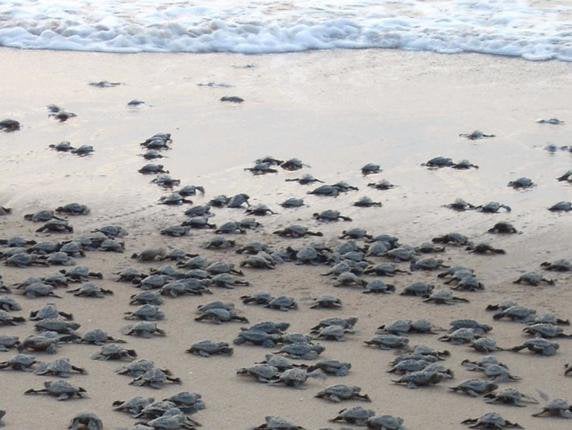More Information
Shouts of excitement and sheer delight from a bunch of watching kids as a group of more than a hundred olive ridley hatchlings are released by volunteers on the beach and make their way down to the sea. Once, twice, sometimes several times, the waves push them back but instinct drives them to keep moving towards the water till a big wave lifts them off their feet and carries them into the ocean – their home!
The volunteers rejoice but their work isn’t done yet. The hatcheries have to be monitored round the clock and every relocated egg has to be accounted for, and every emerging hatchling has to be safely released without falling prey to crabs, stray dogs or the countless crows waiting on the beach.
The Students’ Sea Turtle Conservation Network volunteers work hard every turtle nesting season from December to May, to ensure every nest laid on a 15 Km stretch of beach on the Chennai coast in South India is tracked, removed and relocated to a hatchery and protected till the last hatchling is released into the ocean.

The Students’ Sea Turtle Conservation Network is in its 25th year of olive ridley sea turtle conservation work on the Chennai coast. Sea turtle conservation in India was originally started in the 1970’s in the coast of Chennai city in Tamil Nadu, by herpetologist Romulus Whitaker an Indian of American origin who was running the Madras Snake Park and who then moved on to set up the Madras Crocodile Bank Trust.
SSTCN was started by a group of college students and has been run and sustained for the last 24 years by different sets of students and a few young working adults. The group’s goal has been two fold – firstly, conserving the turtles nesting on Chennai beaches by relocating and protecting nests and releasing hatchlings once they hatch; and secondly, using this activity to create awareness amongst the general public about turtles and also other environmental issues.
Turtle conservation first began because of the danger posed by rampant poaching of eggs on the beach. Over the years poaching reduced but a new danger came up with the encroachments on the beach and the large number of very bright lights on the shore. This has now made relocation a necessity as otherwise, every single new born hatchling emerging from its nest, moves towards the lights on the road instead of towards the sea which would normally be the brighter horizon on a dark beach.
Manned by a dedicated and enthusiastic set of youngsters, SSTCN is active on a 15 Km stretch of beach on either side of the Adyar estuary. From end December volunteers start patrolling the beach stretches looking for turtle tracks which will lead them to a nest. The olive ridley nests twice in a season with an average of a hundred eggs each time. Nests are relocated in 2 hatcheries set up on the beach at the start of the season. Hatcheries are areas fenced off with walls made of bamboo poles and casuarinas poles which are repaired, repainted and reused over several years. Through March, April and May the relocated nests are monitored round the clock. Dangers to the nests take all forms – crabs, stray dogs and crows can easily destroy nests and pick up hatchlings.
In the last 24 years more than 125,000 hatchlings have been safely released into the sea. Volunteers untiringly speak to members of the public, local fishermen and potential poachers about the importance of protecting these ancient reptiles. Through the year, talks and presentations are done in schools and colleges, and inter-collegiate symposiums are held to create awareness.
SSTCN has always followed a policy of being a sustainably run conservation group. Costs are kept to a minimum. But salaries for two fishermen need to be paid for taking up the responsibility of supervising the two hatcheries round the clock for 6 months, along with getting permissions from local police stations for patrolling the beaches etc. We need to hire workers to remove construction debris and garbage and plants from the beach so hatcheries can be set up and we need to cover some repairs and maintenance costs for the hatcheries. We are estimating an expenditure of USD 1600 for the 2012-2013 turtle season.
Some support for our work will be greatly appreciated!